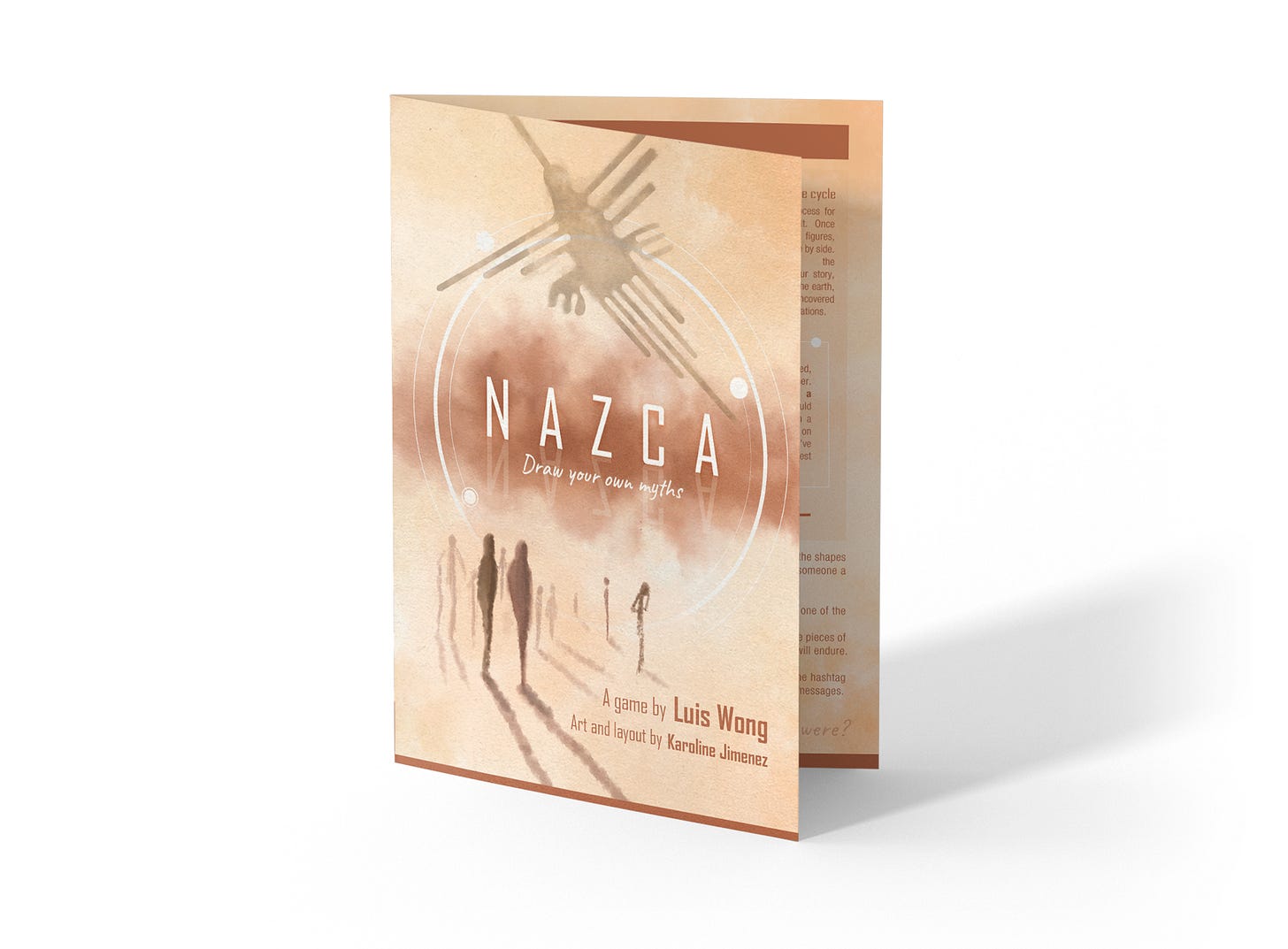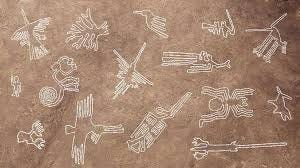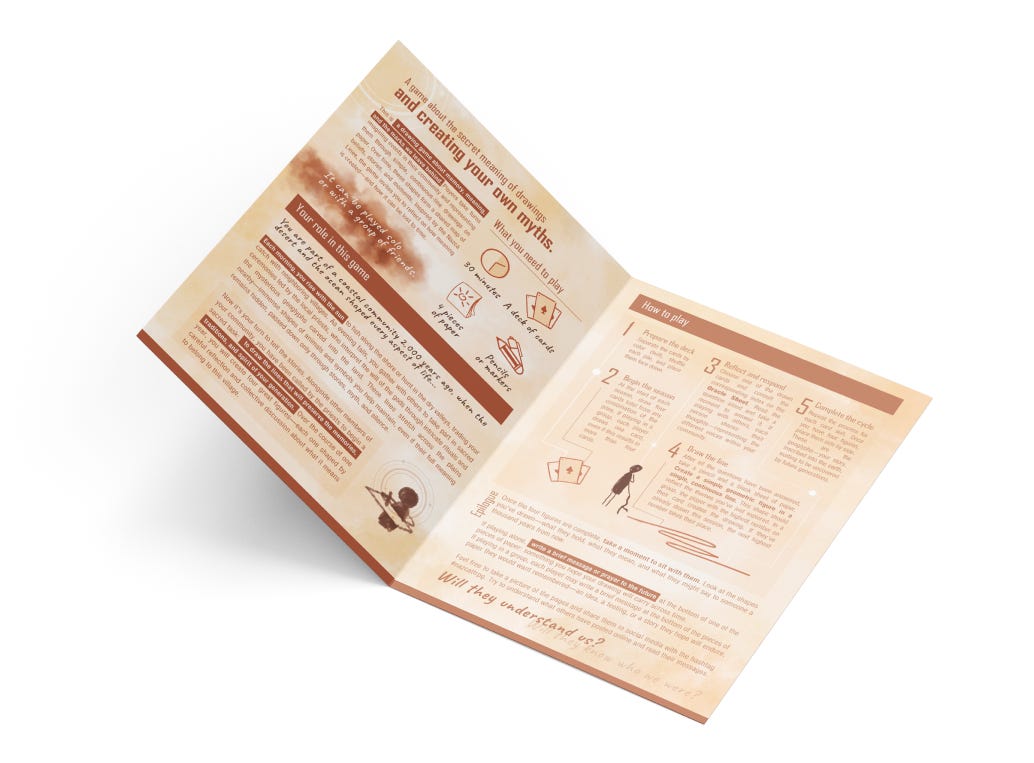I’d been toying with the idea of making a game about the Nazca lines ever since I read the news that hundreds of new figures had been discovered with the help of AI. The sheer mystery of these ancient geoglyphs — massive shapes carved into the desert, visible only from above — felt like the perfect seed for a small, creative TTRPG.
I’ve never actually seen the lines in person. To do that, I’d need to hop into one of those tiny planes that buzz over the Ica desert, south of Lima, which is… let’s just say, not my usual weekend plan. So, in a way, designing this game was my way of getting closer to them — to imagine not just what they look like, but what it might have meant to make them, and the myths they could hold.
This became my entry for the One Page RPG Jam, a fun excuse to distill all those ideas into a single sheet of paper where rules, theme, and imagination live side by side.
🖋️Making a drawing game
Ever since I played The Quiet Year by Avery Alder, I’ve been fascinated by games that ask players to draw. There’s something magical about watching a world take shape under your pen — it pulls you into the fiction in a way that words alone can’t. And it doesn’t matter if you’re a great artist or can barely doodle a stick figure; the act itself is the point.
So when I started thinking about the main mechanic for a game inspired by the Nazca lines, drawing was the obvious choice. The challenge was figuring out how to give that drawing a structure without crushing the creativity.
I landed on two guiding ideas: first, the drawings had to echo the style of the Nazca lines; second, they had to reflect the wonder, beliefs, and concerns of the small community the players embodied. Whether you play alone or with a group, each card you draw gives you a spark — a prompt about your community — and your task is to turn that spark into a single, unbroken line on the page. A symbol. A metaphor. A mark that says, we were here.
In a group, these moments become conversation starters. Players might debate the meaning of a symbol, or argue about how it should be shaped — just as I imagine the Nazca people might have done two millennia ago, standing in the desert and sketching lines that would outlast them. By the end, you’re left with four distinct drawings that, taken together, tell the story of one people from four different perspectives.
🐛Say no to scope creep
An issue I ran into with the first TTRPG I made last year — also for the One Page RPG Jam — was that I tried to fit too much information into the design. Packing it all into a two-sided page was a real struggle. For this game, I wanted to keep things more focused, which also meant leaving more space for the beautiful cover Karoline was going to create.
I concentrated on building an intuitive, compelling game loop, with the dynamics centered on the discussions players would have around the table. The prompts were also more open-ended and straightforward compared to my previous game. I liked the result, and I might keep this design choice for future projects.
Another insight came after I finished the game, when I read an article on Exeunt Press about the lessons learned from Ghost Beacon, another One Page RPG Jam entry. The author mentioned that sometimes certain ideas just don’t fit in the game you’re making — and that’s okay. You can save them for an expanded version later, or park them somewhere and reuse them in a completely different project. I’ve applied this approach to fiction writing before, but now I’m planning to use it more deliberately in my game design as well.
👀Looking Back, Looking Ahead
Designing this Nazca-inspired game wasn’t just about creating something for the One Page RPG Jam — it was about finding a way to get closer to a piece of history I’ve never seen in person, and turning that curiosity into something players could share. Along the way, I came away with three main lessons:
Make something you can relate to — or want to relate to. The more personal the connection, the more the game has a heartbeat.
Keep the scope small. A tighter focus gives you room to breathe — and in my case, room for Karoline’s gorgeous layout and art.
Leave space to grow. Sometimes, ideas don’t fit the current project. That’s fine — they can seed something bigger later.
With this game, I feel like I’ve proven to myself that a small, contained design can still carry a lot of heart. For my next project, I want to take that energy and scale it up into a larger TTRPG — something with more space to explore mechanics, story arcs, and the worlds players can build together.
If you’d like to see what came out of all this — and maybe create your own set of mysterious desert lines — you can check out the game here.






